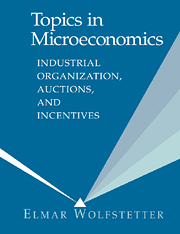Book contents
- Frontmatter
- Contents
- Preface
- Acknowledgments
- I Imperfect Competition
- II Risk, Stochastic Dominance, and Risk Aversion
- III Incomplete Information and Incentives
- 7 Matching: The Marriage Problem*
- 8 Auctions
- 9 Hidden Information and Adverse Selection
- 10 Hidden Information and Signaling
- 11 Hidden Action and Moral Hazard
- 12 Rank-Order Tournaments
- IV Technical Supplements
- Bibliography
- Index
7 - Matching: The Marriage Problem*
Published online by Cambridge University Press: 20 January 2010
- Frontmatter
- Contents
- Preface
- Acknowledgments
- I Imperfect Competition
- II Risk, Stochastic Dominance, and Risk Aversion
- III Incomplete Information and Incentives
- 7 Matching: The Marriage Problem*
- 8 Auctions
- 9 Hidden Information and Adverse Selection
- 10 Hidden Information and Signaling
- 11 Hidden Action and Moral Hazard
- 12 Rank-Order Tournaments
- IV Technical Supplements
- Bibliography
- Index
Summary
No enemy can match a friend.
Jonathan SwiftIntroduction
Many economic problems concern the need to match members of one group of agents with one or more members of a second group. For example, workers need to be matched with firms, graduate students with graduate schools, authors with publishers, landlords with tenants, and men with women, to name just a few.
Matching problems pose three central issues:
Is there a stable matching – one that cannot be upset by individual negotiations?
What procedures or institutions accomplish stable matchings?
Are these procedures manipulable?
This chapter gives a brief introduction to the economics of two-sided matching. To keep matters as simple as possible, we focus on one particular class of matching problems: the matching of two distinct groups (two-sided matching).
Notation and Basic Assumptions
Consider the problem of matching two distinct groups, say W := {w1, …, wn} and M := {m1, …, mn}, metaphorically referred to as the marriage problem. Keeping the particular application of marriage in mind, W may be remembered as the group of women and M as the group of men.
Each man is assumed to have a complete and transitive strict preference defined on W, and each woman has such a preference defined on M. These are conveniently described by a preference matrix, as in the following example.
Example 7.1 The preference matrix below gives the rankings of three men and three women.
- Type
- Chapter
- Information
- Topics in MicroeconomicsIndustrial Organization, Auctions, and Incentives, pp. 175 - 181Publisher: Cambridge University PressPrint publication year: 1999



